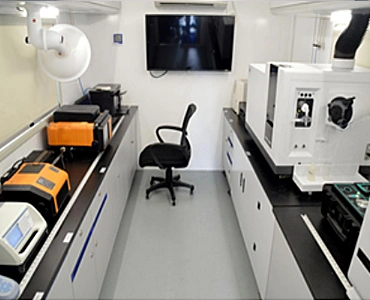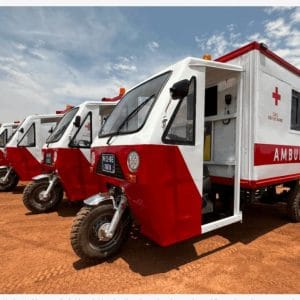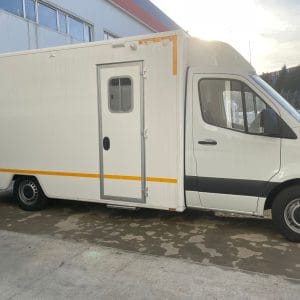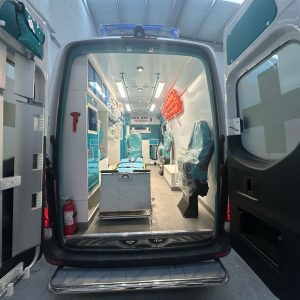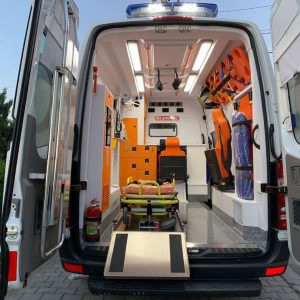1. Introduction to Mobile Laboratories
Mobile laboratories are designed to work in environments where the location of field operations is changing and there are no facilities to support operations. Due to the initial design commitments and the limited flexibility that comes with building a brick-and-mortar facility, the cost of construction and deploying systems in this manner is high. The basic value proposition for the mobile lab is that it can be rapidly moved into a location, set up with a relatively small number of required people, and be conducting operations almost immediately after arrival. The rapid establishment of operations and daily decommissioning of the worksite should not compromise the laboratory’s abilities to fulfill their functions.
The concept of providing speed of response to the analysis is a commonality amongst all these groups, whether that takes the form of rapid sample to result times or rapid deployment to a temporary laboratory site. The system’s agility is often determined by the logistics and modularity of the instrumentation. Extensive work is being done to make the design and fabrication of mobile laboratories quicker, cheaper, lighter, and capable of more functionality. These were also the primary focuses of the MOOBILAB (Modular and Mobile Analytical Systems Laboratory) project. The development of a mobile facility is based on a concept known as Process Analytical Chemistry (PAT) which is flexible, rapid and designed to obtain “the right results in the first place”.
1.1. Definition and Purpose
A mobile laboratory is a laboratory facility that can be installed in a semi-permanent or mobile capacity in a self-contained transportation vehicle. The goal of a mobile laboratory is to provide the ability to run clinical or data tests in a wide variety of locations, including more remote regions, to support a variety of needs. A laboratory of this type must be designed to be able to accommodate laboratory personnel, provide the necessary functions and capabilities to support the intended purpose such as all necessary functions related to the generation of data or the preparation of a specimen, and, when used in purely mobile capacity, must be ruggedized and capable of navigating the common road system of the day without damage to any system, particularly any instrumentation.
Generally, a mobile laboratory contains permanent fixtures such as cabinetry and fume hoods, in addition to electrical systems for safe and reliable operation of instruments. These systems are often included to allow a variety of scientific disciplines to be covered when the lab is regularly deployed in one location. A temporary mobile laboratory is generally outfitted for a specific project with tight integration between instrumentation and support systems which are installed specifically for the project with the intent of being simply removed when the project is completed.
1.2. Benefits and Applications
The mobile laboratory seems to be an innovative solution that is currently being developed, finding diverse applications in practical applications. Several benefits of mobile laboratories have attracted the attention of industry and science, and they include the following: reduced response time, greater sample analysis, and access to smaller sample sizes. They are flexible and can be used by a wide range of end users, from those who require everyday surveillance to those who respond to sudden emergencies, epidemics, land spills, natural disasters, and bioterrorism activities. From industrial drug production to agricultural sectors, the use of mobile laboratories is gaining importance.
A portable bioanalysis system is proposed to meet the requirements of on-site and in situ analysis of organic analytes. The bioanalysis system consists of an analyte extraction module, biofouling sensor assembly, and electrochemical sensor module designed to measure low concentrations of organic analytes, either alone or combined. Microfluidic channels that allow for precise liquid delivery to a biofouling sensor, and magnetically operated bead-based reactors for sample cleanup and preconcentration. This mobile platform can be used to monitor health conditions and analyze human body fluids in a short period of time, indoors or outdoors. This biosensing system fills research gaps and will be part of the available technology that will allow for better and more complete data analysis in the future.
2. Key Components of Mobile Laboratories
The mobile laboratory that is housed in the Integrated Biocontainment Laboratory of the Institute for Human Infections and Immunity has been developed in close cooperation with customs and other port-of-entry stakeholders. To promote the acceptance and rapid deployment of an integrated mobile laboratory (IML), the mobile laboratories run by our international collaborators were reviewed and used as guidelines for our own unit. Three basic documents should guide the construction of IMLs and the educational foundation for building operators, and port-of-entry personnel are being readied for the arrival of an interventional medicine unit. Both documents were reviewed and localized.
Mobile laboratories serve many purposes in our present environment, such as municipal water treatment facility troubleshooting, customs screening, and wastewater effluent testing. The construction, design, and use of conventional commercial mobile laboratories are widely described in the literature. These commercial mobile laboratories typically consist of the box, shell, or cargo trailer vehicle (also known as the building structure or shelter) in which the specialized laboratory equipment and instrumentation and personnel are housed. Because this building provides the environmental and other specifications for laboratory functions such as temperature, air flow, soil and water containment, etc., the chapters also discuss very simple elements of these structures. This chapter will focus on added functions tied to portable laboratories, especially human and animal health response vehicles, and adjacently will discuss some necessary elements of building shelters.
2.1. Structural Design
2.3. Subsystems
Mobile laboratories are designed with multifunctionalism and mobility as examinable characteristics and structure. A key consideration is the architectural plan and layout. The shape and size of the structure is based on the size and number of primary spaces within the lab that are required to be maintained. These are: the work zones, adjoining preparation zones, and administrative spaces. The mobile laboratory also contains functional subsystems.
(1) Structural Design – Mobile laboratory is a structure that is specifically designed to be moved. The dimensions, construction, and sheer volume of the structure must necessarily assume dynamic conditions such as changes in mass (per diem), motions, force, etc. The shape configuration of the cells and their respective dimensions will adhere to optimal design strategies but will chiefly be centered on available space. Availability of materials and space are the key decision-making variables. The construction of the mobile laboratory must rely on widely available off-the-shelf structural components or unconventional yet affordable substitutes.
The application of conventional architectural design, planning, and construction techniques will be a core component of the proposal. However, innovations will be explored and simultaneously adopted where the following conditions apply: potential for superior value of service to available analogue technologies, widespread availability commercial functionality of said technology, simplicity and functionality that allows mass-production. These ‘unconventional’ techniques will also be fledged by design factors that consider spatial desires to relate functional requirements organic yet web-like. These requirements are not oriented orthogonally neither structurally or because space requires them to be J15). Though, the entire laboratory must be intrinsically rigid to maintain usability, despite dynamics in the system.
In order to identify the conventions and the designing a spatial description to be how design can be influenced through problem conceptualizations, extensive space syntax analysis of laboratory day-to-day activities is due to be considered. In the following pages of this paper, we outline the design requirements to stimulate the movable yet essential structure that is the mobile laboratory based on conventional space syntax methodologies.
As the primary point of mobile laboratories is to encapsulate the user’s daily activities wherever it is moved, it is an essential part of the design to ascertain how to move and alternatively dispose of the waste they generate as to leave the most effective minimal imprint possible.
2.2. Laboratory Equipment and Instruments
An assortment of laboratory equipment and instruments is essential to implement chemical, biological, radiological, nuclear (CBRN) or environmental sampling, characterization, and analysis. Some of this specialized equipment requires AC power, which can vary widely in its specifications and availability from location to location, depending on proximity to buildings, trailers, or portable generators. Figure 2-5 provides a partial list of equipment and instruments utilized in mobile laboratories for diverse science and engineering disciplines. Screenshots and pictures are from mobile and transportable laboratories. The portable and handheld instruments are small enough to transport to remote sites or areas powered by a portable generator (3kW capacity) or battery-powered applications.
The accompanying “Label” columns (2nd, 4th, 6th, 8th, and 10th columns) provide general references that identify the technology, company or firm, and representative resources for technical or product descriptions, specifications, and pricing. The Instrument “Type” (3rd, 5th, 7th, 9th, and 11th columns) provides reference information about the names or designations of the analytical techniques. This document only reviews commercially available products and tools, not prototypes or research instruments. This list of laboratory equipment and instruments illustrates the high level of technology, workmanship, precision, and care needed to develop, design, and produce the complex tools and machines necessary for scientific and analytical processes. Mobile and transportable laboratories operate differently with design options for power, infrastructure, control systems, instruments, shelves, cabinetry, workbenches, and emergency equipment.
3. Technological Advancements in Mobile Laboratory Manufacturing
The major technological advancements currently underway are in the field of automation and robotics. The entry of robots is expected to influence the pharmaceutical sector as well. At present, a number of small-scale and medium-scale enterprises have purchased robots for subsequent restructuring to facilitate the prototype process. Many pharmaceutical industries worldwide, especially in the United States, have successfully integrated robots and machine intelligence in the prototype laboratory to provide quality results. Other areas where robots have entered are computer-aided design (CAD)-based prototypes, bio-chemical laboratories for testing, inspecting, calibrating, strengthening, debugging, and replication of prototype objects, anatomical/medical tests, anatomical inspection systems, molecular/biological/nanotechnological studies, and pharmaceutical-cum-diagnosis or robotics-based laboratory research.
At the same time, more advanced innovations in laboratory equipment and mobile laboratory designs are implemented with IoT. Internet of Things is basically a system comprising many equipment, devices, and sensors which constantly communicate with each other and have intelligence that makes them capable of communicating and sharing data with a cloud server. By integrating Internet of Things in mobile labs, numerous advantages are received. A large amount of information is produced by the sensors in the labs that assist researchers in conducting their investigations more effectively. Even though various fields of American philanthropy are supporting the remake of mobile laboratories, presently the primary emphasis is on how best to standardize, making it even more effective during an incident. This huge financial support provided to produce mobile laboratories is practical and is giving an overall pay-off, like cost savings and efficient tracking and logistics.
3.1. Automation and Robotics
Automation is one of the most transformative technologies in history. It revolutionized industry and moved it into the modern era. Manufacturing, which was once slow, hazardous, and unreliable, became automated through the integration of mechanical and electronic technologies. According to the Automation Federation, industrial automation in engineering means the development and application of control systems, devices, and software, all aimed at keeping the systems running without human intervention. Robotics, which will be discussed separately, is a broad and growing field in automation and control engineering.
3.1.1 Advantages of Automation There are countless benefits from this type of technology. For instance, it results in lower production costs and reduces errors. Automated manufacturing controls the complete process, from producing a piece of equipment to packaging – with a few exceptions, human hands never touch it. After the machines and software are designed and put into place, labor costs are minimal. The assembly lines can be full of machines working 24 hours a day with almost no human intervention. Instead of a large staff of employees serving just a few hours weekly, a handful of workers will be required for cleaning, maintaining, and fixing the machines. Finally, machines do not need breaks. They can work on statutory holidays and can even work in subzero temperatures. The more recent line of robotics technology has further ushered in a new revolution with respect to mobile laboratory manufacturing, bringing yet greater automation and control.
3.2. IoT Integration
Integration of IoT in mobile laboratory manufacturing. IoT, or the Internet of Things, brings intelligence and interconnected data-driven functionalities to mobile laboratories. There are mainly three functionalities that IoT brings into mobile laboratories. These are receiving the remote vehicle performance data in real-time and from other vehicles that are partners in the same convoy, validating the quality and accuracy of the measurements onboard a mobile laboratory through cross-verification by connecting it to stationary devices already set up on other chosen locations, and providing alarms in case of an unusual event on any of the in situ measurements at all the locations. The absence of such remote connectivity previously meant that conclusions could only be driven after a metropolis to validate the mobile laboratory measurement in situ.
Following is the list of additional concepts that can be implemented as part of the mobile laboratory manufacturing for using IoT. Remote data acquisition from column heating, gradient oven, headspace sampler which can be an in-built database. This data can provide additional information to the mobile lab for the raw material matching control. The gradient oven can be configured in a region where technique some of our partners have used in pharmaceuticals of selecting “ovens”) and mobile Lab can identically or closely match the TGA curves. This in-built database can be linked to our Tip Tooling program or the database available in the industry that would show the desired pre-defined curve (TG curve) changes over temperature.
Aleuronic Acid) to the surface of D-mannose is spiraled upwards around the D-mannose at the other end of the ligand chain. This ligand, however, was compared to one note of the changing of the ligands through mass spectral analysis indicating three product ions were generated from one monosaccharide moiety of DFHG-. The other product reached three product ions for the dimers if dextran the other moiety identified by MS was either selected D-GLU containing O1-O1 linkages similar to APY(FRUCTOSE), 3,4-DCDN, or C1-C1 linkages sgaporei pak kh ng- they were not dextran as the binding among the four other neat OMH, I, 11 AI 1 2017 321 Interactive Design Bureau for the Coatings and Drying Unit of a Mobile Laboratory Special Interest Group in Education 322 OMH, I, 11 AI 1 2017 PQG251 SQL Syntax For PostgreSQL 323 OMH, I, 11 AI 1 2017 Review of the Dispersion Instrumentation Available for the National Robotics Initiative, 2016 324 OMH, I, 11 AI 1 2017 new addition to the in situ mobile laboratory sample analysis schedule.
3.1. Guideline The guideline for the design or manufacture of the IoT smart mobile laboratories is to combine the functionalities between the stationary and mobile laboratory. That means to collect on remote services the date of the setup of a respective (twin) lab with the same or alike reachable facilities (like a connected grid, growing zone, connected products and their related standards, etc.) and to modify in accordance a designed mobile laboratory to a laboratory bench at a “connected” place. This would permit the checking of this bench and its personnel and to correlate to other data obtained by other labs using the same or different methods that on the end could help in validate measuring data or develop a new testing standard.
4. Case Studies of Successful Mobile Laboratory Projects
The following examples include in-depth case studies of specific mobile laboratory projects that will help planning for new or modified mobile laboratory initiatives. The projects have been chosen to illustrate a diversity of operational models, audiences, and trends in mobile testing and deployment. Their contents are based on information supplied by the mobile laboratory operators and are oriented towards similar practices. The detail of some operational projects is not disclosed.
a. Tissue Culture Mobile Laboratory, Plant & Food Research. This bus-based laboratory travels to New Zealand schools and helps raise awareness about the value of plants and plant pathologists, facilitates active “hands-on” learning, and provides resources for teachers. The content of the bus and laboratory activities is developed with the reopening of New Zealand’s Junior Professional Programme in mind, with at least two core “activities” intended to carry over into the newly developed science awareness section of the PVR website. For example, the bus and laboratory activities and resources may show children “who are into science” that careers in science do not necessarily mean a life spent in a distant lab away from interesting and engaging issues. The bus and laboratory activities may also demystify the world of science for primary and secondary (Years 1 – 12) pupils. Instructors are encouraged to adapt the activities for tertiary level with consideration of their special circumstances (e.g., laboratories, classroom environment, available resources, and cultural differences).
b. The ACER/AusAid Asia Pacific Quality Network. From an initial focus on the quality of science education, the outcomes of this project will have important implications not only for science quality in the secondary school years but for the sciences and education generally. Developing the project has involved identifying science quality models at the middle school levels; consulting with a range of stakeholders and developing a set of benchmarks using performance indicators to identify ‘what’ students need to know and be able to do. These benchmarks will be used to underpin assessment of student performance through a series of curriculum-based tests in each of the years 8-10. A second set of tests will assess students using knowledge learned in practical science and technology. The project will include capacity building in the development of technical assessment and the analysis of assessment data. Data collected will be analyzed and reported at system-wide and national levels, and the outcomes used to “tell the story” of quality of outcomes and changes in classroom pedagogy. Science Assessor training module. “How to create reference points – the inter-grade science survey”.
5. Future Trends and Opportunities in Mobile Laboratory Manufacturing
The interest in mobile laboratory manufacturing will continue to increase due to the rising number of research conducted in open environments where no standard laboratories are available, keeping in mind the high level of equipment and chemicals that are moved into these areas. As a result of the ‘two-fold approach’, new investments in satellite laboratories are expected to continue to grow. Informatics and ICT functionalities will become more important to suggest the best practices to be adopted and to provide a fertile continuous learning approach. The construction 4.0 process of low-cost mobile laboratories will enable the training of new employees, the verification of new business safe protocols, and the dissemination of technology to attract industrial investments, particularly in the biotechnology and biology sectors, as an index of a safe area for the environment.
Mobile laboratories have been created and mounted in cargo sea containers. Integrating a wheeled version of these laboratories could bring the laboratory exactly where the research is taking place, bringing down rents and drastically cutting researchers’ time, who are willing to move their micro-lab from one place to another in Andalusia in hydro enough moving trucks. Investments to create this laboratory 4.0 will be very efficient in order to investigate global phenomena such as climate change and the spread of pests, for example. A replica of these basic low-cost scientific labs in containers is starting to be sold outside the university and is required in various industrial processes where validation of the same mobile lab is required. From a pedagogic point of view, the laboratories are and can be used. Future trends and opportunities may see an expansion of mobile laboratories.


